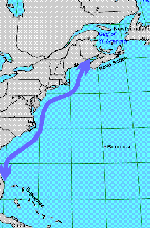
Today's News

Spring's Journey North

Report Your Sightings

Search Journey North
return to:

 A/CPB
A/CPB
Right Whale Migration Update: February 18, 1998
Greetings from the Stellwagen Bank National Marine Sanctuary -- If you are National Geographic magazine readers
-- check out the March issue -- I just got mine today. They have a great article about the National Marine
Sanctuary Program, with an interesting section about issues related to fish and whales in this sanctuary.
 |
|
Migration Route of North Atlantic Right Whales Map courtesy of |
Chris seems somewhat discouraged -- not only that the weather is not
cooperating with the field season, but that the number of cow/calf pairs
spotted to date has been quite low (possibly a maximum of 10). Last year
there were over 20 births recorded down in the calving grounds.
The weather up north has been much better, in comparison to the Florida/Georgia coastline. Aerial overflights
and boat patrols in Cape Cod Bay have recorded up to 25 whales. Marilyn Marx, a researcher with the Center for
Coastal Studies, reports that the whales have been skim feeding on thick plankton patches and also displaying surface
active behaviors.
Over the past few days they've seen the following whales:
- 1911 (a male born in '89)
- 1706 (a female born in '87)
- 1802 (a female born in '88)
- 1704 (a female who had her first calf last year) and
- 1280 (unknown age and sex).
The whales up north right now seem to cover a wide variety of ages, but a good portion are younger females and males (net yet of breeding age which is usually 9-15 in female right whales), or in the case of 1704, a whale that recently had a calf (right whales can have a calf every 3-5 years). Cow/calf pairs have not yet started to make their way north yet.
Last report I asked how researchers can identify these whales (knowing that right whales do not have the fluke
patterns of humpbacks). Ms. Cook's students at Penn Valley Elementary School had the answer: "Our class studies
whales in the Voyage of the Mimi program. Their answer to your question is: 'scientists identify right whales
by their callosities, the bumps on their head.'" (jcook@mciunix.mciu.k12.pa.us)
From Minoqua, Wisconsin, 7th grade student Katie Fricke added that colosities are cornified skin patches. (Sandy_Roggow@mail.mhlt.k12.wi.us)
The researchers do use the callosity pattern on each whale's head to identify the individual. These white areas
are rough, cornified epidermis (thick skin patches) that are unique for each whale. They occur on whales in all
the same areas that humans have hair -- on the top and sides of their heads, over their eyes, near their ears,
around their blowholes and under their lips and chins. The white (or yellowish or pinkish) color comes from the
mass of small amphipod crustaceans called cyamids or "whale lice" that live on the rough skin patches.
No one knows for sure the role of these whale lice -- perhaps they play a cleaning role, consuming sloughed skin.
In addition to the callosity pattern, distinguishing scars aid in identification -- and, unfortunately, many whales
display scars from both natural causes (killer whale attacks usually in youth) and fishing gear.
Until my next report, this is Anne Smrcina, education coordinator for the Stellwagen
Bank National Marine Sanctuary signing off.
The Next Right Whale Update will Be Posted on March 4, 1998.



